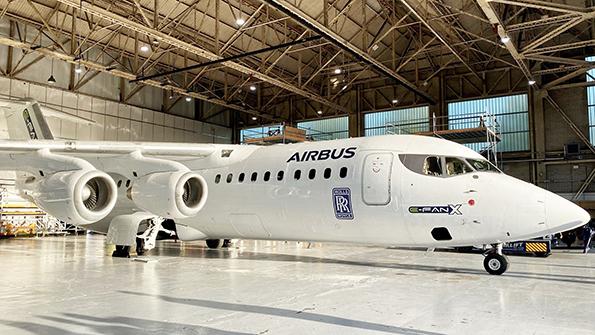What Radical Engine Changes Means For The Aftermarket | 发动机领域的变化对售后市场意味着什么

发动机制造商正在为新一代先进低排放动力装置制定发展战略,包括多电技术、混合电推进技术、分布式推进架构、氢燃料电池和碳中性燃料等在内的很多新技术。
Engine-makers are laying out tentative development strategies for a new generation of advanced lower-emissions powerplants that embrace everything from more-electric and hybrid-electric technology to distributed propulsion architectures, hydrogen fuel cells and carbon neutral-fuels.
但是,对于售后市场来说,传统涡轮式发动机的售后市场规模已达数十亿美元,而这些新技术对于这些传统发动机的MRO行业意味着什么呢?售后市场的规则是否会改变,随着该行业向着新的可持续的领域发展,传统的MRO服务提供商会越来越受到冷落吗?
But what does this mean to the established multibillion-dollar engine aftermarket industry that has flourished for so long on maintaining, repairing and overhauling the conventional gas turbine? Is the game about to change, and will the traditional service providers be increasingly left out in the cold as the industry moves toward a brave new, sustainable world?
尽管自喷气机时代开始以来,发动机领域向新技术的转移往往领先于售后市场的发展,但当涉及到发动机制造商的发展方向和时间表时,其存在的问题往往比答案更多。唯一可以确定的是,随着机身和发动机制造商努力在2050年前将二氧化碳排放量减少到2005年水平的50%,新技术带来的变化正在发生。
While the shift to new technologies will inevitably be more radical than anything the aftermarket has seen since the start of the jet age, there are currently more questions than answers when it comes to what directions the engine OEMs will take and when. The only certainty is that changes are on the way as airframe and engine-makers work toward reducing CO2 emissions to 50% of 2005 levels by 2050.
目前在短期阶段内,可能广泛采用的可持续性航空燃料对发动机MRO领域几乎没有影响,但除此之外,其他新技术的影响则不能忽视。虽然全电推进系统的开发正在进行中,但电池的能量密度有限,这意味着目前全电推进将局限于载货无人机、城市空运飞行器,以及其他电动垂直起降飞行器等应用。
A short-term change with almost no known implications for engine MRO will be the broader adoption of sustainable aviation fuels. But beyond this, the picture is murkier. Although development of all-electric propulsion systems is underway, the limited energy density of batteries means the concept will necessarily be limited to applications such as unmanned cargo drones, urban air mobility and other electric vertical- takeoff-and-landing vehicles.
虽然在商用飞机领域,电推进的发展较慢,但这也不意味着发动机MRO可以忽略电推进系统的挑战。例如发动机制造商已经在计划使涡扇发动机具有更强的发电能力,这既可以满足未来客机的电力需求,又可以通过使用电力来优化发动机运行从而节省燃油。
However, this doesn’t mean engine MROs can ignore the electric revolution. Engine-makers are already planning to make turbofans more electric—both to feed future airliner power needs as well as to potentially gain fuel savings by using electric power to optimize engine operation.
普惠公司正在研究PW1100G齿轮传动涡轮风扇发动机的下一代产品,这可能是采用并联涡轮-电力的混合动力发动机,其效率比当前发动机高5%,并且可用于下一代单通道客机。
Pratt & Whitney is studying a next-generation PW1100G geared turbofan that could be a parallel turboelectric hybrid engine, which could be up to 5% more efficient than current engines and be available for the next generation of single-aisle airliners.
罗罗公司在制造其“超扇”(UltraFan)齿轮传动风扇发动机的首台演示样机的同时,已经在考虑开发带有嵌入式启动发电机的“微混合”动力系统。
Rolls-Royce, which is building the first demonstrator of its new UltraFan geared turbofan for tests starting in 2021, is already pondering “micro-hybrid” electric versions with embedded starter-generators.
8月,美国能源部获得了3300万美元的合同,以开发全电动力总成和燃油-电能的转换技术,以减少未来的单通道客机的排放量,从而为未来实现更多的电力使用铺平道路。
Paving the way for a more electric future, in August the U.S. Energy Department awarded $33 million in contracts to develop all-electric powertrain and fuel-to-electric power-conversion technologies to reduce emissions of future single-aisle airliners.
这些计划涵盖了电动飞机的高性能能量存储、发电系统(包括燃料到电力转换),还包括开发具有先进热管理系统的超高效全电动力总成,这表明美国 不打算在未来的电动力系统竞赛中落后。
Covering everything from high-performance energy storage and power generation subsystems for electric aircraft—including fuel-to-electric power conversion—to developing ultra-efficient all-electric powertrains with advanced thermal management systems, the programs make a statement that the U.S. does not intend to fall behind in the more-electric race.
目前很明确的信息是,各种形式和功率级别的混合动力系统即将到来,而发动机MRO供应商应不仅要适应、还应考虑利用潜在的市场机会。除了未来的单通道客机具有更多的电力功能以外,新一代的全电小型通勤飞机和混合动力的支线飞机也正在出现。由于这些飞机承诺具有更低的运行成本,它们未来的使用规模可能会比今天更大。
The clear message is that electric power, in various forms and levels of hybridization, is coming, and MRO providers should think about how not only to adapt but also to take advantage of the potential market opportunities. As well as more electric features on future single-aisles, a new generation of all-electric small commuter and hybrid-electric regional aircraft is on the horizon and, because of their promised low operating costs, they could be in service in far greater numbers than today’s generation.
除了电力以外,人们对氢能的兴趣也在不断增长。现在氢能被视为一种使航空业(尤其是在欧洲)深度脱碳的方法,如空中客车公司将开发氢能飞机,并计划在2035年将采用氢能的、碳净排放量为零的飞机推向市场。
Beyond electric power lies a growing interest in hydrogen. Although discounted as a viable option for aircraft until very recently, hydrogen is now viewed as a way to deeply decarbonize aviation—particularly in Europe. Airbus sees the fuel as one way to meet its stated commitment to bring an aircraft with net-zero carbon emissions to market by 2035.
尽管由于氢能的生产和运输所需的基础设施成本高昂,这使在航空领域应用氢能的早期努力失败了,但气候变化的势在必行和欧洲的“飞行羞辱”(flight-shaming)运动迫使人们重新考虑氢能应用的可行性。
While earlier efforts to bring hydrogen to aviation have failed because of the high cost of the infrastructure required for production and distribution, the climate-change imperative and the “flight-shaming” movement in Europe have forced a reconsideration.
那么基于氢的能源生态系统对MRO行业意味着什么呢? 几乎可以肯定的是它将提供大量的新机会,因为氢即可用于为电推进系统的燃料电池中,也可以在涡轮发动机中直接燃烧提供能量。而运用氢、可再生电力和捕获的二氧化碳也可用于生产碳中性的合成燃料。
So what could the adoption of a hydrogen ecosystem mean for the MRO industry? Almost certainly it would present significant new support opportunities, as hydrogen can be used in fuel cells powering electrified propulsion systems or directly combusted in gas turbine engines. Hydrogen, renewable electricity and captured CO2 can also be used to produce carbon-neutral synthetic fuels.
在这种巨大变化的背景下,要使所有发动机MRO的工作人员都心存希望是很重要的,即传统形式的燃气轮机不会消失,至少在接下来的几十年中不会消失。罗罗公司的航空技术和未来计划主管Alan Newby表示,传统的燃气轮机还有很多机会参与未来的竞争,站在发动机制造商的角度看,无论是长期使用可持续性航空燃料还是最终用氢作为燃料,一台高效的燃气涡轮发动机仍然是必要的。
Against this backdrop of dramatic change, there is one great certainty to warm the heart of all engine MRO operators: The gas turbine is not going away—at least not for the next few decades. Alan Newby, director of aerospace technology and future programs at Rolls-Royce, echoes his competitors when he says gas turbines have plenty of runway left ahead. “From our point of view, whether or not it is fueled by sustainable aviation fuel or even ultimately hydrogen in the long-term future, you’re still going to need a highly efficient gas turbine,” he says.
这条消息是Guy Norris在Inside MRO发表的文章。加入航空周刊情报网(AWIN)会员,访问公司、项目、机队和联系人数据库,获取权威解析与市场情报并找到新的业务机会。点击击此预约您的产品演示。